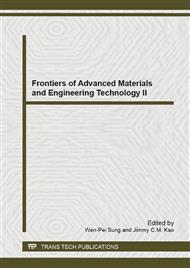[1]
Lomax K S. Business failures: Another example of the analysis of failure data[J]. Journal of the American Statistical Association, 1954, 49(268): 847-852.
DOI: 10.1080/01621459.1954.10501239
Google Scholar
[2]
Chahkandi M, Ganjali M. On some lifetime distributions with decreasing failure rate[J]. Computational Statistics & Data Analysis, 2009, 53(12): 4433-4440.
DOI: 10.1016/j.csda.2009.06.016
Google Scholar
[3]
Bryson M C. Heavy-tailed distributions: properties and tests[J]. Technometrics, 1974, 16(1): 61-68.
DOI: 10.1080/00401706.1974.10489150
Google Scholar
[4]
Arnold B C. Pareto distribution[M]. Wiley Online Library, (1985).
Google Scholar
[5]
Johnson N L, Kotz S, Balakrishnan N. Continuous Multivariate Distributions, volume 1, Models and Applications[M]. New York: John Wiley \& Sons, (2002).
Google Scholar
[6]
Childs A, Balakrishnan N, Moshref M. Order statistics from non-identical right-truncated Lomax random variables with applications[J]. Statistical Papers, 2001, 42(2): 187-206.
DOI: 10.1007/s003620100050
Google Scholar
[7]
Howlader H A, Hossain A M. Bayesian survival estimation of Pareto distribution of the second kind based on failure-censored data[J]. Computational statistics & data analysis, 2002, 38(3): 301-314.
DOI: 10.1016/s0167-9473(01)00039-1
Google Scholar
[8]
Abd-Elfattah A M, Alaboud F M, Alharby A H. On Sample Size Estimation For Lomax Disrtibution[J]. Australian Journal of Basic and Applied Sciences, 2007, 1(4): 373-378.
Google Scholar
[9]
Ghitany M E, Al-Awadhi F A, Alkhalfan L A. Marshall–Olkin extended Lomax distribution and its application to censored data[J]. Communications in Statistics—Theory and Methods, 2007, 36(10): 1855-1866.
DOI: 10.1080/03610920601126571
Google Scholar
[10]
Cramer E, Schmiedt A B. Progressively Type-II censored competing risks data from Lomax distributions[J]. Computational Statistics & Data Analysis, 2011, 55(3): 1285-1303.
DOI: 10.1016/j.csda.2010.09.017
Google Scholar
[11]
Giles D E, Feng H, Godwin R T. On the bias of the maximum likelihood estimator for the two-parameter Lomax distribution[J]. Communications in Statistics-Theory and Methods, 2013, 42(11): 1934-(1950).
DOI: 10.1080/03610926.2011.600506
Google Scholar
[12]
Dempster A P, Laird N M, Rubin D B. Maximum likelihood from incomplete data via the EM algorithm[J]. Journal of the Royal Statistical Society. Series B (Methodological), 1977: 1-38.
DOI: 10.1111/j.2517-6161.1977.tb01600.x
Google Scholar
[13]
Ng H K T, Chan P S, Balakrishnan N. Estimation of parameters from progressively censored data using EM algorithm[J]. Computational Statistics & Data Analysis, 2002, 39(4): 371-386.
DOI: 10.1016/s0167-9473(01)00091-3
Google Scholar
[14]
Kundu D, Pradhan B. Estimating the parameters of the generalized exponential distribution in presence of hybrid censoring[J]. Communications in StatisticsTheory and Methods, 2009, 38(12): 2030-(2041).
DOI: 10.1080/03610920802192505
Google Scholar
[15]
Louis T A. Finding the observed information matrix when using the EM algorithm[J]. Journal of the Royal Statistical Society. Series B (Methodological), 1982: 226-233.
DOI: 10.1111/j.2517-6161.1982.tb01203.x
Google Scholar


